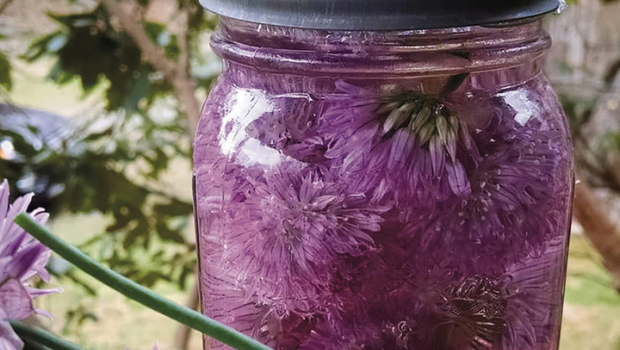Flower Power: Edible Blooms Add Flavor and Color to Summer Fare
Fruits, leaves, stems and roots are commonly eaten as part of a plant-based, farm-to-table diet, but until recently, the only flowers on the table were in a vase. Today’s health-conscious foodies are finding edible flowers to be a fantastic way to eat the rainbow, adding fun flavors and colors to all sorts of dishes.
Urban homesteader Holly Capelle turned her family’s backyard in the Portland, Oregon, suburbs into expansive edible gardens, enjoyed by their flower-eating chickens and children alike. “We grow everything from seed, including 15 to 20 edible flower varieties, from spring through fall,” says Capelle. “I love to grow edible flowers for two reasons: one, to eat, and second, for the natural pest control they provide. I think of flowers as a beautiful army that I can eat along the way.”
Capelle’s favorite edible flowers are pansies and violets, as they “pop up again and again all growing season and make a beautiful garnish without overpowering flavor.” The home gardener likes to freeze the fresh flowers in ice cubes, press them on the outside of herb butter or dry them between pieces of wax paper to later add to the tops of homemade chocolate bars, along with dehydrated strawberries, lemon balm, mint or other botanical flavors.
The family’s fowl get in on the flower fun, too. “We make frozen treats for the chickens out of edible flowers, corn and strawberries, which they love in summer. We also add dried flowers like marigolds to their nesting boxes,” she says, adding that marigolds, with their bright orange hues and distinct flavor, are great in scrambled eggs or as a substitute for saffron.
For larger blooms like sunflowers, Capelle recommends pulling off the often-hard centers. “I often see whole zinnias on edible cakes, but no one wants to eat an entire zinnia. With daisies, for example, I will pull off the petals and recreate the flower on top of a dish, using peppercorns or chocolate chips in place of the center,” she says.
Capelle also loves chamomile for its distinctive, apple-like flavor that has the “feel of fall,” and dianthus, with a slightly spicy taste like cloves. “Nasturtiums are another super defender in the garden, with a delicious peppery flavor and nice orange pop of color in a salad,” she adds.
“Flowers brighten any dish up, especially hors d’oeuvres, omelets and soups. Pea soup is an ugly soup, but sprinkle some microgreens and a viola on top and it’s beautiful,” says Jan Bell, of Gilbertie’s Organics, in Easton, Connecticut. The 34-acre farm, which recently celebrated its 100th anniversary, grows herbs, vegetables and microgreens in 24 greenhouses, including a microgreen blend with nasturtium and viola flowers. “If you pick the flowers on herbs, the plant will grow better and last longer,” Bell adds.
Flowers like wild violets, chive blossoms and common milkweed can add bold color and flavor to vinegar with pinkish purple hues that power up salad dressings. Bell also likes to dry chive flowers to use year-round. “They are a nice purple sprinkle to add to dishes when things are boring in winter,” she says.
Marie Viljoen, a New York City forager, chef and author of the cookbook Forage, Harvest, Feast: A Wild-Inspired Cuisine, incorporates numerous wild and cultivated flowers, including tree flowers like magnolia and black locust, into her hyperlocal, seasonal meals.
Even common garden roses can add a delicious dimension to dishes and drinks, according to Viljoen. “I like to ferment roses into a simple soda, using organically grown rose petals, honey or sugar and tap water. It’s ready within a few days, or else you can leave to ferment a few months to make a sipping vinegar,” she says. “You can also combine really fragrant rose petals with a neutral honey like clover, then strain after a few days for a rose water essence you can add to yogurt or other dishes.” Viljoen also uses rose petals as edible garnishes for deviled eggs or as edible plates for goat cheese balls on her gourmet picnics.
Some flowers are for the eyes only, however. Many can be poisonous, so it’s important to ensure a particular species is edible before digging in. Viljoen also advises carefully distinguishing between poisonous lookalikes when foraging: A delicious daylily and a toxic true lily look similar, but are in different plant families, for example. She also says to look for organically grown flowers that haven’t been sprayed with pesticides.
Connect with Washington, D.C., freelance writer April Thompson.




























